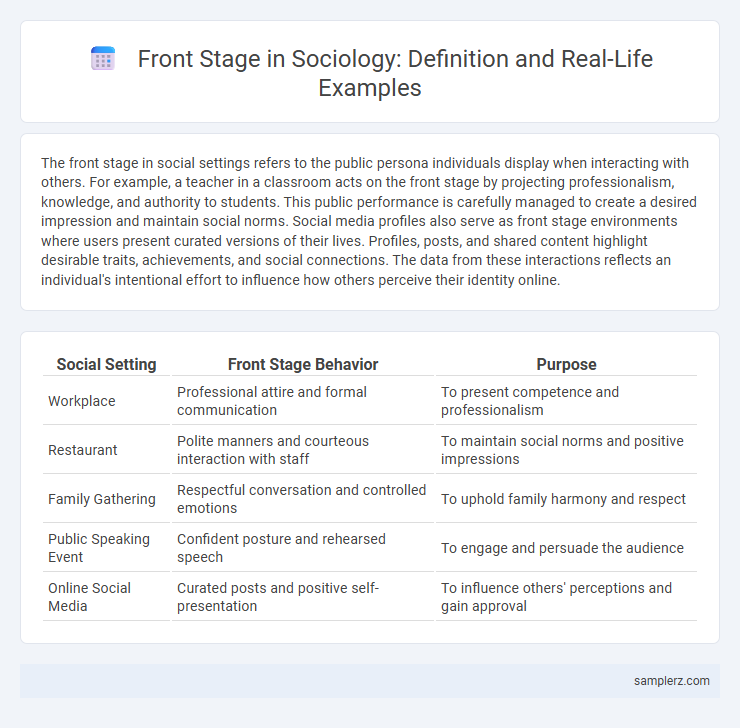The front stage in social settings refers to the public persona individuals display when interacting with others. For example, a teacher in a classroom acts on the front stage by projecting professionalism, knowledge, and authority to students. This public performance is carefully managed to create a desired impression and maintain social norms. Social media profiles also serve as front stage environments where users present curated versions of their lives. Profiles, posts, and shared content highlight desirable traits, achievements, and social connections. The data from these interactions reflects an individual's intentional effort to influence how others perceive their identity online.
Table of Comparison
| Social Setting | Front Stage Behavior | Purpose |
|---|---|---|
| Workplace | Professional attire and formal communication | To present competence and professionalism |
| Restaurant | Polite manners and courteous interaction with staff | To maintain social norms and positive impressions |
| Family Gathering | Respectful conversation and controlled emotions | To uphold family harmony and respect |
| Public Speaking Event | Confident posture and rehearsed speech | To engage and persuade the audience |
| Online Social Media | Curated posts and positive self-presentation | To influence others' perceptions and gain approval |
Everyday Politeness: Greeting Coworkers
Greeting coworkers with a simple "hello" or "good morning" exemplifies front stage behavior in social interactions, showcasing everyday politeness and professionalism. These greetings help establish a respectful and friendly atmosphere in the workplace, reflecting social norms and expected etiquette. Consistent use of such front stage behaviors contributes to positive coworker relationships and a collaborative work environment.
Social Media Profiles: Curating Online Persona
Social media profiles function as the front stage in social interactions, where individuals meticulously curate their online personas to manage impressions and influence perceptions. Profile pictures, bios, and posts are strategically selected to reflect desirable traits and social identities, often emphasizing achievements, affiliations, and lifestyle choices. This curated presentation shapes how audiences interpret the individual's social role, reinforcing desired narratives and fostering engagement.
Customer Service Smiles: Interacting with Clients
Customer service smiles serve as a pivotal front stage performance, where representatives engage clients with warmth and approachability to foster positive interactions. This deliberate display of friendliness helps build trust and enhances the overall customer experience, influencing client satisfaction and brand loyalty. Smiling not only conveys attentiveness but also masks backstage complexities, ensuring a seamless and inviting social encounter.
Dining Etiquette: Behaviors at Formal Events
Dining etiquette at formal events includes using the correct cutlery for each course, maintaining proper posture, and engaging in polite conversation. Guests avoid interrupting others, wait for the host to begin eating, and signal when finished by placing utensils together on the plate. These behaviors demonstrate respect, social awareness, and adherence to cultural norms in public dining settings.
Classroom Participation: Student Responses to Teachers
Classroom participation exemplifies front stage social behavior where students consciously perform roles by responding to teachers' questions and engaging in discussions to project knowledge, attentiveness, and conformity. These responses often align with expected classroom norms, reflecting a strategic presentation of self to influence teachers' and peers' perceptions. This dynamic illustrates Erving Goffman's concept of front stage, where social interactions are carefully managed to create desired impressions within an educational setting.
Public Speaking: Presenting to an Audience
Front stage in social settings involves public speaking where individuals consciously perform and manage impressions during presentations to an audience. This environment emphasizes verbal communication, body language, and audience engagement to convey credibility and authority effectively. Speakers often prepare meticulously to ensure clarity, confidence, and persuasive impact according to social expectations.
First Impressions: Meeting Someone New
First impressions play a crucial role during social interactions, shaping how individuals perceive one another when meeting for the first time. Facial expressions, body language, and tone of voice contribute significantly to the formation of these initial judgments. Understanding the importance of front stage behavior in social settings helps improve communication and fosters positive relationships.
Job Interviews: Showcasing Professionalism
During job interviews, candidates engage in front-stage behavior by meticulously presenting their skills, qualifications, and professional demeanor to create a favorable impression. This performance includes dressing appropriately, articulating experiences clearly, and demonstrating confidence to align with the employer's expectations. Such deliberate self-presentation reflects the strategic management of social identity in high-stakes professional interactions.
Hosting Gatherings: Playing the Perfect Host
Hosting gatherings exemplifies the front stage in social interactions, where the host carefully curates the environment, manages guests' experiences, and maintains social norms to create a welcoming atmosphere. Effective hosts skillfully navigate impression management by paying attention to details such as seating arrangements, conversation facilitation, and hospitality rituals. This performative aspect highlights the importance of social roles and expectations in fostering connections and ensuring guests feel valued and comfortable.
Community Volunteering: Performing Altruism in Public
Community volunteering showcases front stage behavior as individuals publicly engage in altruistic activities, demonstrating social values and commitment. This visible participation fosters community trust, reinforces identity, and encourages reciprocal support within social networks. Public acts of kindness serve as social signals, enhancing reputation and promoting collective solidarity.

example of front stage in social Infographic
 samplerz.com
samplerz.com